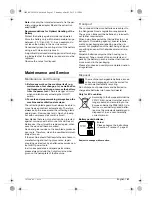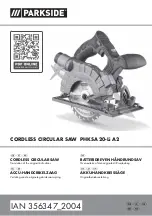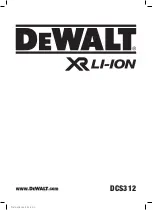
English |
41
1 619 P12 706 • 5.3.15
Note:
Use only the intended screws to fix the par-
allel guide/guide adapter
32
and the extraction
adapter
29
!
Recommendations for Optimal Handling of the
Battery
Protect the battery against moisture and water.
Store the battery only within a temperature range
between –20 °C and 50 °C. As an example, do
not leave the battery in the car in summer.
Occasionally clean the venting slots of the battery
using a soft, clean and dry brush.
A significantly reduced working period after charg-
ing indicates that the battery is used and must be
replaced.
Observe the notes for disposal.
Maintenance and Service
Maintenance and Cleaning
Before any work on the machine itself (e.g.
maintenance, tool change, etc.) as well as dur-
ing transport and storage, remove the battery
from the power tool.
There is danger of injury
when unintentionally actuating the On/Off
switch.
For safe and proper working, always keep the
machine and ventilation slots clean.
The retracting blade guard must always be able to
move freely and retract automatically. Therefore,
always keep the area around the retracting blade
guard clean. Remove dust and chips by blowing
out with compressed air or with a brush.
Saw blades that are not coated can be protected
against corrosion with a thin coat of acid-free oil.
Before use, the oil must be removed again, other-
wise the wood will become soiled.
Resin and glue residue on the saw blade produces
poor cuts. Therefore, clean the saw blade immedi-
ately after use.
If the machine should fail despite the care taken in
manufacturing and testing procedures, repair
should be carried out by an after-sales service cen-
tre for BTI power tools.
In all correspondence and spare parts orders,
please always include the 7-digit order number
given on the nameplate of the machine.
Transport
The contained lithium-ion batteries are subject to
the Dangerous Goods Legislation requirements.
The user can transport the batteries by road with-
out further requirements.
When being transported by third parties (e.g.: air
transport or forwarding agency), special require-
ments on packaging and labelling must be ob-
served. For preparation of the item being shipped,
consulting an expert for hazardous material is re-
quired.
Dispatch batteries only when the housing is un-
damaged. Tape or mask off open contacts and
pack up the battery in such a manner that it cannot
move around in the packaging.
Please also observe possibly more detailed nation-
al regulations.
Disposal
The machine, rechargeable batteries, acces-
sories and packaging should be sorted for
environmental-friendly recycling.
Do not dispose of power tools and batteries/re-
chargeable batteries into household waste!
Only for EC countries:
According to the European Guideline
2012/19/EU, power tools that are no
longer usable, and according to the
European Guideline 2006/66/EC, de-
fective or used battery packs/batter-
ies, must be collected separately and
disposed of in an environmentally
correct manner.
Battery packs/batteries:
Li-ion:
Please observe the instructions
in section “Transport”, page 41.
Subject to change without notice.
OBJ_BUCH-2434-001.book Page 41 Thursday, March 5, 2015 2:19 PM

































